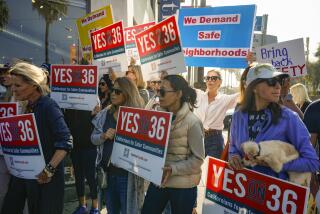Prop. 11 lead signals voters’ reform mood
- Share via
FROM SACRAMENTO — It’s still too close to call, but the ballot initiative to reform legislative redistricting is looking like a probable winner.
Counties continue to count absentee and provisional ballots. As of Wednesday afternoon, Proposition 11 held a slim 1.6% lead -- roughly 153,000 votes, with up to 1.8 million ballots still to be tallied, according to the secretary of state. The measure actually has widened its lead by half a percentage point since election night Nov. 4.
So let’s assume it passes. What’s next? Here’s what:
By stripping the Legislature of the power to draw its own districts, California voters have opened the door to more political reform.
Next up in efforts to untangle the partisan gridlock and make the state Capitol more functional: A probable ballot initiative in 2010 to return state elections to some form of open primary system. All candidates would compete in the same primary and the top two vote-getters, regardless of party, would advance to the November runoff -- similar to the way local officials are elected.
The idea is to force candidates in the primary to appeal to a wider swath of voters than merely their own party members. Presumably that would result in the election of more pragmatic moderates.
California had another version of an open primary system in 1998, but the Supreme Court ruled it unconstitutional. Since then, Washington state has adopted a “top two” system that the Supreme Court has sanctioned. And that’s the model for California reformers.
There was troubling news for reformers on Nov. 4, however. Oregon voters, by nearly 2 to 1, rejected a “top two” proposal after strong opposition from the two major political parties, who feared they’d be weakened.
“Parties have degenerated into a philosophical wasteland,” says former Democratic state Sen. Steve Peace of San Diego, who is drafting a “top two” ballot initiative. “Their core agenda is a mindless pursuit of election wins with no sense of governing once you get there. They’ve gotten far out of step with the public.”
Also increasingly possible now that Californians are in a political reform mood: Controlling the runaway initiative process, which has become a tool of deep-pocket special interests and a full employment act for political consultants. Reformers talk about giving the Legislature a crack at tinkering with initiatives before they reach the ballot. If the lawmakers and initiative sponsors compromised, that could result in better law.
And likewise more conceivable: relaxing legislative term limits. But next time, it would need to be a term limits proposal that doesn’t blatantly benefit incumbents. Such a legislative-backed initiative was rejected by voters in February.
There also could be a budget reform package: stronger spending constraints coupled with elimination of the unworkable two-thirds legislative vote requirement for budget passage.
All this is more likely because Prop. 11 -- which follows several failed attempts at redistricting reform -- demonstrates to sponsoring good-government groups that the California electorate is, indeed, interested in overhauling the abstract, wonky state political process. And it encourages them to take the next steps.
“It sends a message that the public is clearly dissatisfied with the Legislature and it wants to see some change, and it doesn’t expect the institution to change itself,” says James P. Mayer, executive director of California Forward, a new reform group that supported Prop. 11.
The measure’s passage will create some wind behind the reform sails of Gov. Arnold Schwarzenegger, who donated nearly $3 million to Prop. 11 and campaigned hard for it. He’s also an advocate of open primaries.
“We have a system in place,” Schwarzenegger says, “where getting stuck in our ideological corners is being rewarded, and compromise is being punished.”
Prop. 11’s impact won’t be felt for four years when the first class of legislators affected by it is elected. They’ll run in districts redrawn after the 2010 census by a 14-member citizens commission. No longer will the self-serving Legislature be allowed to gerrymander districts to protect incumbents and the political status quo.
Democratic leaders cry that Prop. 11 isn’t fair. That’s because Democrats outnumber Republicans in voter registration by roughly 4 to 3, but there’ll be an equal number of party members (five each) on the citizens commission. Of course, that’s the whole idea of reform: to eliminate political considerations and draw districts that are geographically logical and hopefully more competitive.
The commission also will draw state Board of Equalization districts. But U.S. House seats will continue to be gerrymandered by the Legislature. Reforming congressional redistricting would have been too difficult politically, generating barrels of opposition money from the likes of House Speaker Nancy Pelosi (D-San Francisco).
Former Democratic Assembly Speaker Bob Hertzberg of Van Nuys, a Prop. 11 supporter, says good riddance to legislators drawing their own districts. It’s “a cloud hanging over our head” that helps make the public increasingly cynical about Sacramento, he argues.
“As Democrats, we have to inspire confidence in government because we believe in an activist government,” says Hertzberg, one of the leaders who presided over the last gerrymandering in 2001. “When people have confidence in government, they will support education bonds, mental health programs, opportunities for kids in college.
“We just need to get this issue behind us.”
Redistricting reform is no cure-all, by any stretch. But it is an important first step toward making legislative contests more competitive, lawmakers more accountable and pragmatic and Sacramento more workable and relevant to voters’ lives.
And if Prop. 11 fails, delete above.
--
More to Read
Get the L.A. Times Politics newsletter
Deeply reported insights into legislation, politics and policy from Sacramento, Washington and beyond. In your inbox twice per week.
You may occasionally receive promotional content from the Los Angeles Times.











